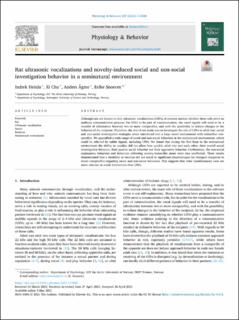| dc.description.abstract | Although rats are known to emit ultrasonic vocalizations (USVs), it remains unclear whether these calls serve an auditory communication purpose. For USVs to be part of communication, the vocal signals will need to be a transfer of information between two or more conspecifics, and with the possibility to induce changes in the behavior of the recipient. Therefore, the aim of our study was to investigate the role of USVs in adult rats’ social and non-social investigation strategies when introduced into a large novel environment with unfamiliar conspecifics. We quantified a wide range of social and non-social behaviors in the seminatural environment, which could be affected by subtle signals, including USVs. We found that during the first hour in the seminatural environment the ability to vocalize did not affect how quickly adult rats met each other, their overall social investigation behavior, their passive social behavior nor their aggressive behavior. Furthermore, the non-social exploratory behaviors and behaviors reflecting anxiety/stress-like states were also unaffected. These results demonstrated that a disability to vocalize did not result in significant disadvantages (or changes) compared to intact conspecifics regarding social and non-social behaviors. This suggests that other (multi)sensory cues are more relevant in social interactions than USVs. | en_US |

